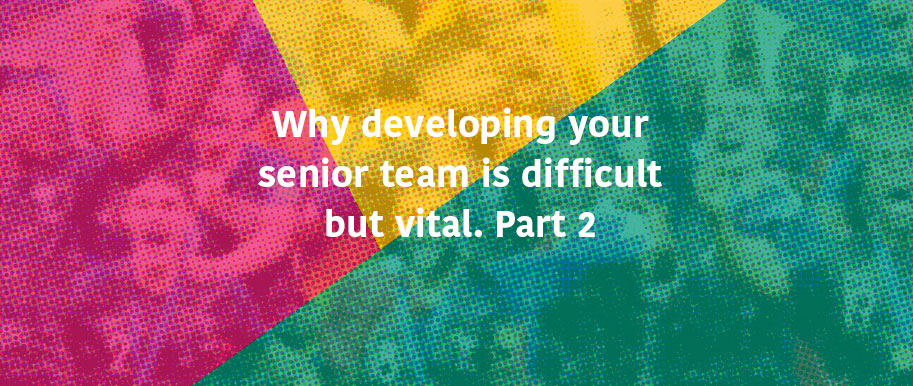Making adjustments to the way things have always been is never easy. Whether at home or in business, change is usually stressful, disconcerting, hard work – especially when it’s you that needs to change.
Yet this is exactly what we must ask our senior leaders to do when the team at the top isn’t performing as well as it could. The process isn’t always comfortable, there are obstacles and challenges to overcome before any difference can be made, yet changes at the top lead to outcomes which are beneficial for the entire organisation.
What does a senior intact team development programme involve?
To really affect change at a senior level, development programmes must break the focus down into three parts: me, us and them. In this structure, the focal point begins firstly with the individual and gradually zooms out to look at the whole senior team and the wider organisation.
With greater consciousness comes greater choice and behavioural flexibility. Increasing the ability of leaders to take control of and responsibility for their own behaviours at an individual level enables this to be applied to a team setting, and finally in a leadership role.
So how can you do this?
Each stage of the senior team development differs slightly; at its core is coaching.
Personal coaching
Coaching is a powerful tool to facilitate development at a senior level. Starting with individual coaching raises leaders’ awareness of their behaviour, their communication style, how they relate to others and how they impact on the people around them. This involves the exploration of personality, values, beliefs and bias and emotional intelligence.
It’s important that deep psychological assessment is balanced with opportunities for leaders to explore and reflect on their experience. Equally important, the programmes must not hide behind ‘content’. This is what makes coaching so effective, because it places the onus for learning on the ‘student’ rather than the ‘teacher’. If senior leaders are learning models instead of addressing their behaviour and its impact then they will simply opt-out and be learning passengers rather than active participants. Passivity seldom delivers results and if senior leaders are permitted to be passive at an individual level, then results at a team and organisation-wide level certainly won’t emerge.
Tips and things to remember:
- Ensure your coaches are experienced; they must understand how to agitate and probe without getting side-tracked down a rabbit hole by bright, assertive people.
- They must be wholeheartedly committed to creating a development experience which holds up the mirror to people, however uncomfortable they might find it.
- When the work is challenging, remember that without this uncomfortable journey of self-discovery, senior leaders won’t change as they won’t perceive the need to change.
Team coaching
Building on the work carried out an individual level, coaching with a senior intact team explores similar themes of behaviour and values, this time through the lens of a group. The aim is to enable the senior team to work together more effectively. Individuals need to have a greater understanding of each other to achieve this. Developing a sense of curiosity about themselves leads to greater curiosity about one another, which takes the place of secretiveness and finger-pointing that exists in a dysfunctional team.
Tips and things to remember:
- To foster a sense of openness, leaders will need to be vulnerable. It’s often extremely challenging for anyone to admit weakness or discuss their most personal beliefs, especially for those who head a large organisation. It’s essential that the programme provides a safe psychological space, free of judgement and ridicule.
- Compassion forms a large part of being able to relate to one’s colleagues. Equally important is the compassion that leaders show themselves, which they must be encouraged to do.
The filter effect
The final piece of the puzzle is to look at how leaders can transpose the lessons they have learned individually and with peers to the wider business. Understanding their impact on the rest of the organisation begins with an understanding of how to lead by example and inspire.
Key to this is showing their human side. Being comfortable with vulnerability at a team level will enable senior leaders to be vulnerable in front of those they lead. Admitting that they don’t have all the answers, that they need the help of their staff, empowers the very people who are being led. By demonstrating humility, they elicit trust and respect from their staff. In turn, staff feel that it’s OK to be human, to make mistakes and to say ‘I don’t know’, and feel more inclined to work hard for the organisation. Trickling down from the senior team this authenticity radiates from the top to all corners of the organisation.
The ends justify the means
It is true that delivering a programme which challenges, agitates and prompts a behavioural change in senior leaders is no easy feat. It requires time out of the office for leaders to genuinely disconnect from work, to stop and to think deeply. It requires leaders to be vulnerable and open, which can be an extremely uncomfortable experience. Coaching, while no silver bullet, is the most effective method with which to address obstacles at an individual and team level, for the benefit of the entire organisation.
And while the biggest changes that emerge as a result of coaching senior leaders are to do with their behaviours, the effects are far-reaching: greater trust, transparency and better business results. If you can persuade your senior team, that it is vital that they are open to this development, you might just see the type of culture that most L&D leaders can only dream of blossoming in your own organisation.
